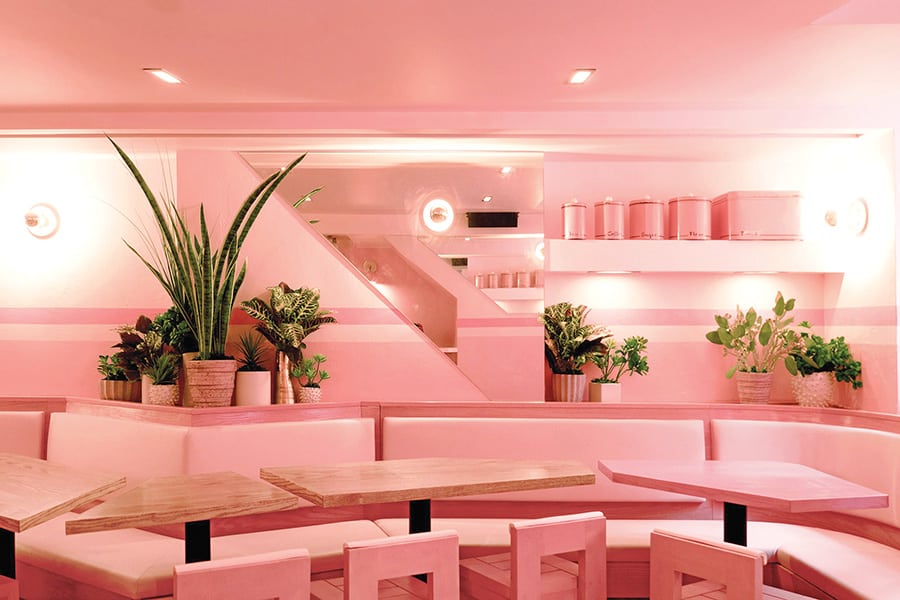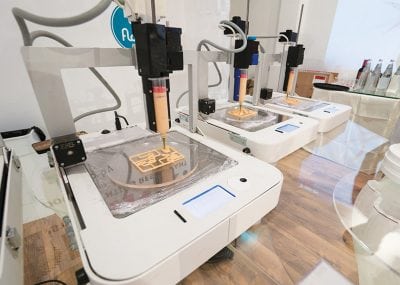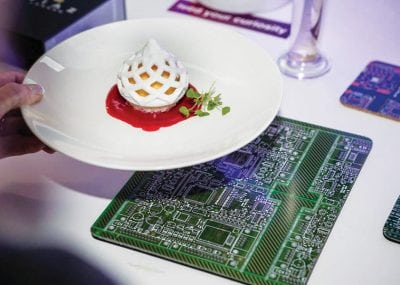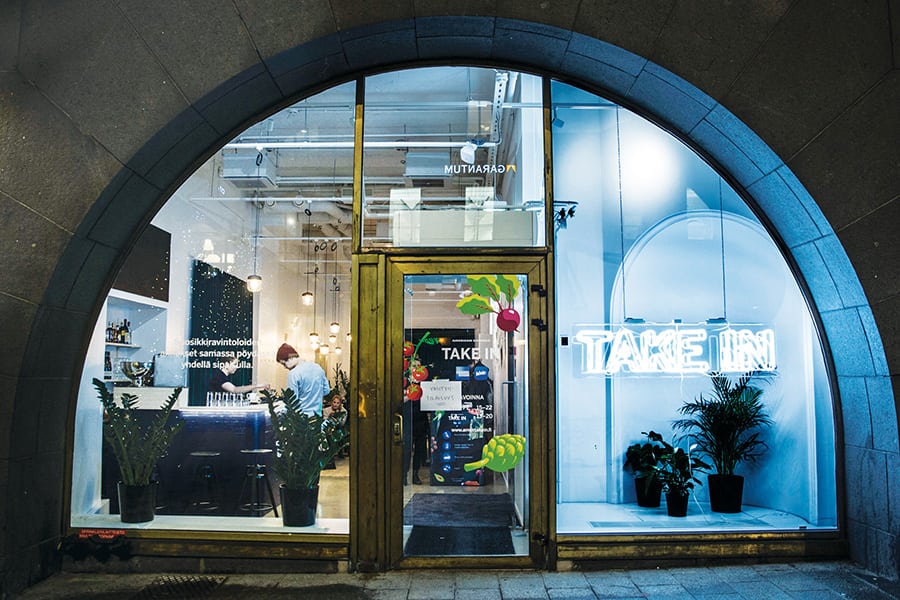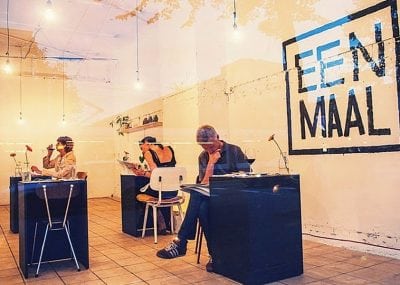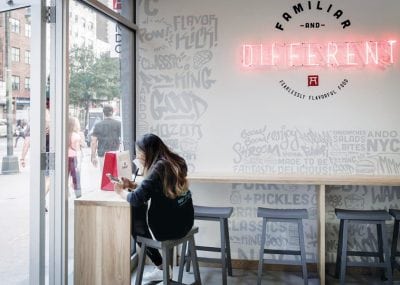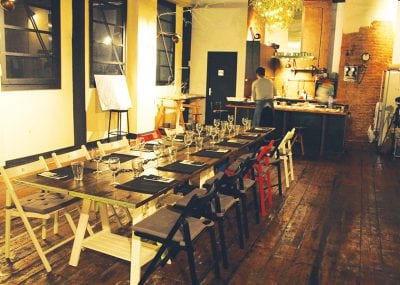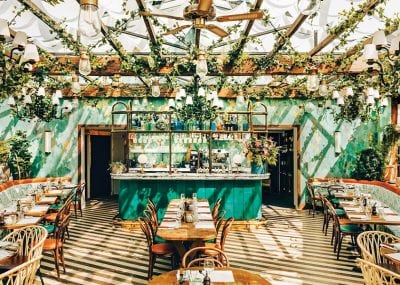From demand for plant-based foods and flower power to the growth of innovative concept restaurants and all the ‘Instagram worthy’ meals in between, these are just some of the food trends predictions we have been bombarded with in the past couple of years.
Even though we all know food trends are fleeting, to say the least, some common themes nowadays include the rise of the veggie-centric menus and hyper-local foods and people developing more meaningful connections with their food – whether that be through dining in a restaurant or cooking at home. Less food waste, natural ingredients and our grandmothers’ cooking techniques to help us look at our pantry with different eyes and make every ingredient resourceful from nose to tail, are all back in vogue.
“’Cucina Povera’ is the new black,” claims Italian celebrity chef Massimo Bottura. Restaurants, cafés, and bars alike are taking a ‘less is more’ approach with smarter ingredients, sustainable practices, and local-oriented producers. Of course, you’re unlikely to see the words ‘starter’ or ‘main’ on a menu anymore. Everything is to be shared.
In addition to the human factor, technology and innovation are rapidly spreading beyond Uberisation to 3D printed food and face payments – a mix between the real and the digital world distinguishes new retail. And social media continues to drive food trends, from the rainbow coloured everything to the continuing impact of a social movement like #MeToo on the restaurant industry.
The future of restaurants tends to be more informal, seeking a more democratic and popular cuisine, but with a focus on creativity and innovation. The sector is also moving towards premium segments because consumption is more and more aspirational and experiential. Finally, we are seeing some new thought-provoking dining concepts that are challenging the whole notion of eating out as such, where restaurants are increasingly not looking like restaurants and even food is not food as we know it.
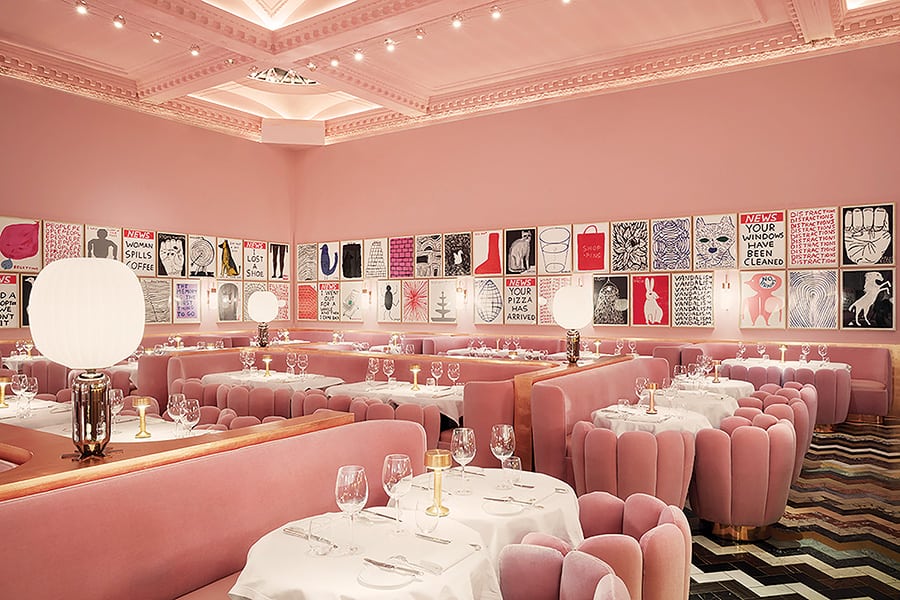
Sketch, London – one of the most Instagrammable restaurants in the world
Lights, camera, dinner
From flattering lighting and expressive kitsch to graphic tiling and graffiti walls literally made for selfies for entrepreneurs seeking social media glory, no detail is too small to consider.
While Instagrammable foods like bubble-wrap waffle ice creams and unicorn lattes have been responsible for drawing in crowds waiting in line to take photos of the food before they eat it, now it’s all about creating styled experiences to go with it. Designers call it an ‘Instagram moment’, creating an actual space in the eatery that looks photo ready.
Instagram has changed the food and the way we eat. Of course, word of mouth still plays a part, but what’s changed is that word of mouth has now moved online.
According to recent research, millennials spend five whole days a year browsing food images on Instagram, and 30% would avoid a restaurant if their Instagram presence was weak.
Since social media can make or break, the socially-savvy eateries often go to extremes like some of the most Instagrammable restaurants in the world, NYC’s Pietro Nolita and Sketch, London, literally all-pink restaurants, or Boston Chops steakhouse that has a special $10,000 Instagram table with movable shadow-eliminating overhead lights and adjustable colour temperature settings, that would make even a giant T-Bone look pretty. For Media Noche in San Francisco, the hook is the intricately patterned tile floor, but it also has other Instagram triggers like banana-print wallpaper in the bathrooms and an exterior mural of pink flamingos, their heads bowed into the shape of a heart. According to the owners, the average diner spends at least ten minutes taking photos before they even order and many even bring tripods to better frame their shots.
But it’s all worth it, since if you didn’t Instagram it, did it even happen?
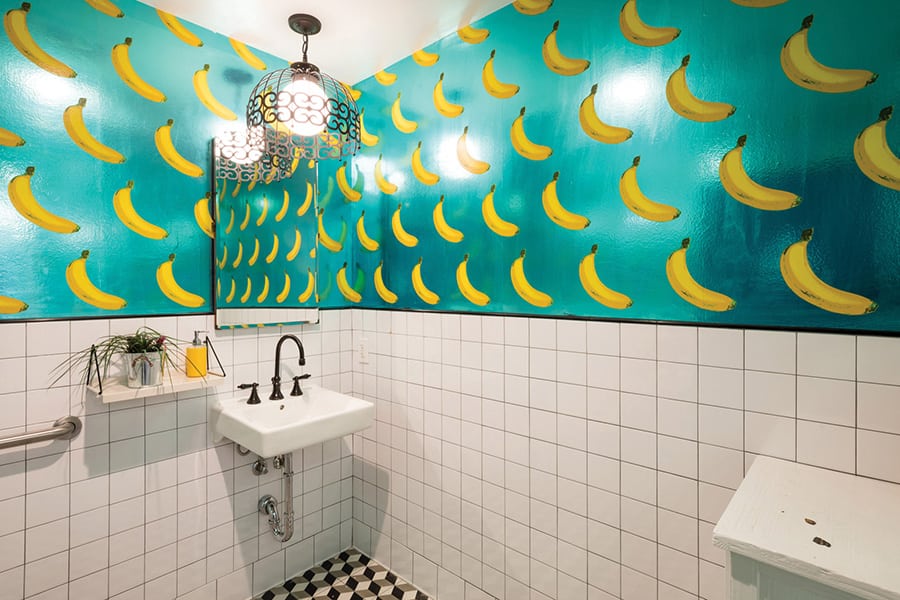
The banana-print bathroom of Meida Noche restaurant, San Francisco
From pixels to printer to plate
Unthinkable only a few years ago, Food Ink is the world’s first restaurant serving 3D-printed food with 3D-printed utensils at 3D printed tables. Bringing together architects, artists, chefs, designers and engineers, this conceptual pop-up diner prides itself on being a place where fine food intersects with science, technology and futurism. According to their stated philosophy, the team is “putting to work most innovative technologies, like 3D-printing and augmented reality, in order to elaborate the most exquisite interactive edible experience”.
- 3D printed food
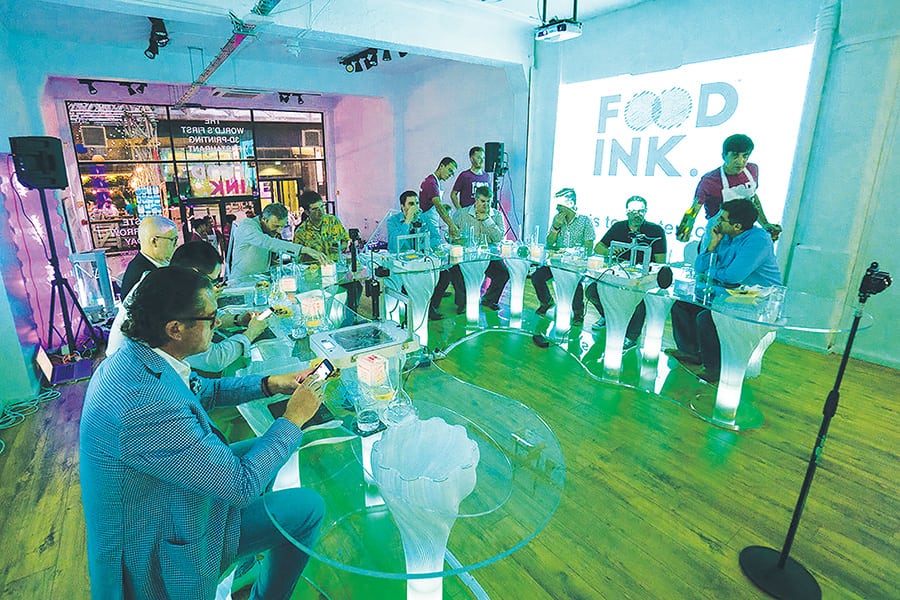
If you are worried, rest assured – everything on the menu at Food Ink is edible, despite being made by a machine and not a human. In a process that looks similar to piping icing out of pastry bags, ingredients are pureed, packed into 3D moulds, and then ‘printed’ with a Dutch-made 3D printing machine called ByFlow. The moulds are guided with the robotic ‘arm’ of the printer to create dishes at a level of precision rarely achieved by a human chef. Together, they’re creating foods like olive caviar served on a Petri dish, smashed peas, pizza dough and chocolate mousse, all printed live in front of an audience.
The restaurant, which officially first opened in London, has been popping up in locations all over the world. The concept hopes to inspire conversation about the future of sustainable food, nutrition, and health as well as demonstrate how emerging technologies may be changing our dietary and cultural habits. However, making and serving food has been intrinsically linked to the human experience for millennia and it’s difficult to predict what consequences this new technique could have. For now, 3D food printers are largely the reserve of high-end dining but the Food Ink creators believe that within as little as two years, everyone will be casually printing out Spaghetti Bolognaise for weeknight dinners.
Work, eat, play
Collaborative economy already reached food but New York’s newest creative hub, A/D/O, is pushing the boundaries by blending food, design, retail and community engagement all under one mural-covered roof. Located in the converted Brooklyn warehouse, A/D/O is a 7,000m2 design space from BMW’s Mini intended to explore innovations that improve urban life. The multi-functional area includes a design academy, a winter garden, an exhibition area, a 140-seat restaurant, a design store and a co-working area. The all-day restaurant, from Scandinavian hotshot chefs, is open to the public but it also offers a co-working menu and co-working space, while in the evening the area is curtained off and the restaurant opens in its fine dining format with candles and seasonally-inspired dishes. By late night, the marble bar is geared towards cocktails, beers and natural wines, ensuring that the spot becomes a perpetual hangout. According to the official statement, in collaboration with the creative community at A/D/O, Norman is to explore the intersection between culinary innovation and design, with the aim of pushing new boundaries in food.
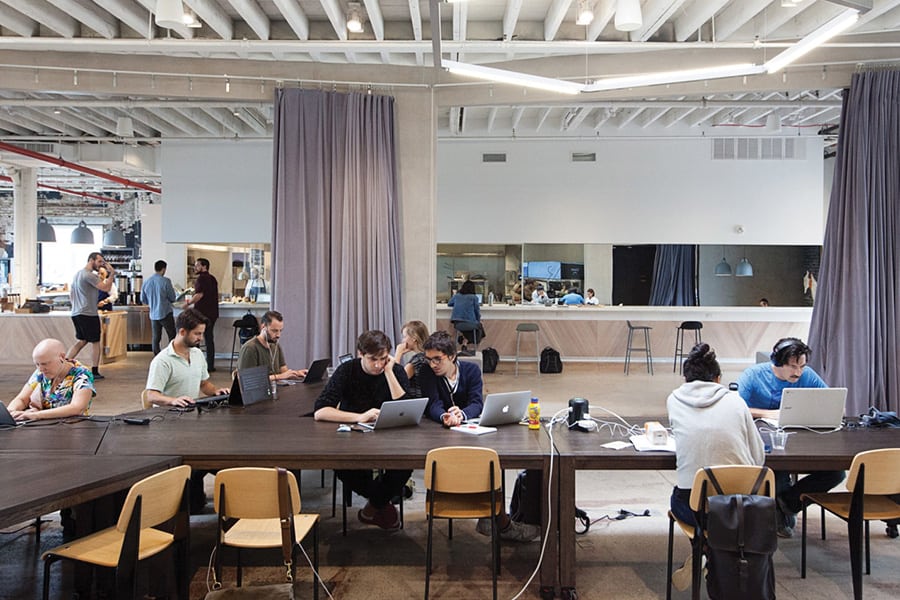
A/D/O in Brooklyn NYC blends food, design, retail and community engagement all under one mural-covered roof
Restaurants without seats, seats without restaurants
All things considered, traditionally, a typical restaurant has been defined by the bricks-and-mortar, the food being served, having the kitchen and the seats, but apparently we don’t need all that anymore. Instead, we can now have “restaurants without seats, seats without restaurants”, as coined by the highly influential international restaurant consultants Baum+Whiteman. Though, at first this might sound like it’s about food trucks, they’re actually talking about the impact of mobile tech on restaurants and dining in general, with technology making it possible to make and take food orders anywhere.
There is a growing trend for restaurants and food brands to set up full-scale commercial kitchens usually in offbeat locations. The seatless restaurant is simply a production centre staffed by professional chefs and no dining area. Instead, the high quality meals are made-to-order and delivered to diners at their homes. It is a form of upmarket takeaway but on an industrial scale. In other words, they are ‘restaurants without seats’. Among pioneers, New York’s Momofuko by David Chang, one of the most influential chefs in the world, started the trend with Ando, his delivery-only brand, though recently he sold it to Ubereats, which may be a sign that Uber is getting more serious about the quality of the food it’s delivering.
The ‘seats without restaurants’ idea refers to the commercialisation of supper clubs and various at-home pop-ups, also increasingly referred to as the “social eating revolution”.
In the same way that Air B’n’B has revolutionised the way that private individuals rent out their rooms, companies like the Paris-based venture VizEat, provide a way for home cooks to invite tourists into their home for a paid meal.
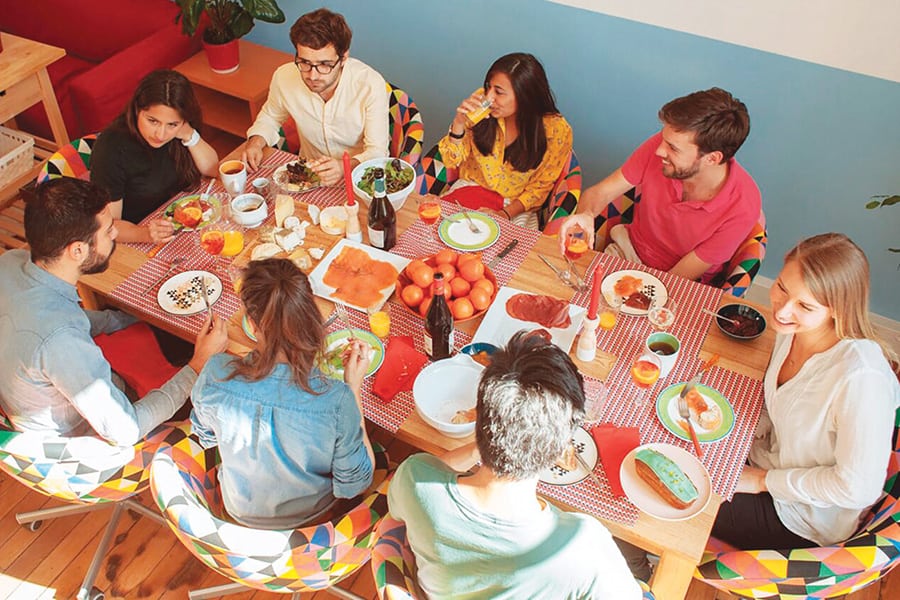
VizEat (short for Visit-Eat)
Hosts don’t have to be professional cooks – anyone from students to retirees can sign up, deciding their own menus and price points. They don’t have to provide a sit-down meal, either. For VizEat (short for Visit-Eat), operating now all over the world, social dining is about providing a more authentic experience for travellers, as per their motto: ‘taste the city with locals’.
A new alternative to regular takeaway apps, e-start-ups, such as Trybe, London, are assembling networks of home cooks in the local community to prepare made-to-order authentic meals and deliver them to people’s dining rooms. The community-based food app essentially matches hungry customers to their neighbourhood cooks, helping to form new connections within the community as a result. While food can be delivered, a growing number of people now prefer to collect the meal themselves, allowing them to hear the story behind the food they eat and to establish a connection with their neighbours through their shared love of cooking and eating.
Restaurants without kitchens
‘Take In’, a pop-up communal space in Helsinki created by American Express, is challenging the notion of a traditional restaurant setting by allowing diners to order food in from an app called Wolt. The restaurant features everything that you would expect from a hip establishment, such as sleek wooden tables, silverware and lush plants, as well as full bar service and waiting staff – the only thing missing is a kitchen. Essentially, Take In provides a space for those who have ordered takeaway meals but don’t necessarily fancy eating alone.
The 50-seat restaurant without a kitchen also offers a solution for couples and groups who might want to eat Indian and pizza at the same time!
Take-In, Helsinki
In an interview with Monacle, Wolt’s spokesperson talks about the democratisation of dining that this concept provided, offering not only choice and customisation to the diner but also the need for the participating fine dining establishments to optimise their food for delivery to a broader audience. While it seems like a concept designed for solo diners, the spotlight is on communal dining or ‘co-eating’ and the pop-up stresses the concept of a “living room in the city”.
Table for one
While Take In is aimed at those who don’t want to dine alone, one restaurant in Amsterdam provides a place for those happy to do precisely that. Created by two Dutch design agencies, Eenmaal’s noble intention is to de-stigmatise, or even to glamourise, solo dining. Billing itself as the world’s first solo eatery, the restaurant features 10 tables with one chair and one serving space each while the interior decor is kept absolutely minimal to avoid distraction, giving the diners a chance to appreciate the high quality food. There is no wi-fi, encouraging guests to instead read books and magazines or simply enjoy their food. The restaurant received very positive reactions via social media and from visitors who agree that solitary dining can be an inspiring experience in our hyper connected world just because you can disconnect for a while.
- Eenmaal, Amsterdam
- Ando by David Cheng
Eenmaal, Take In and Food Ink, all join a host of various quirky venues to have opened around the world in recent years, some of which were inconceivable only a few years ago. The fact that these new concepts have been receiving media attention for their non-restaurant tendencies shows not only forward-thinking restaurant industry trends and technologies but also, more importantly, the shifting sands of consumer behaviour.
Clearly, in these enthralling and ever-changing times, forecasting the future is a fun but often futile exercise, we just have to wait and see what tomorrow’s food trends and concepts will bring, or take away. Until then, happy dining.
- Hidden Factory Supper Club, Barcelona
- Pink Mamma, Paris


